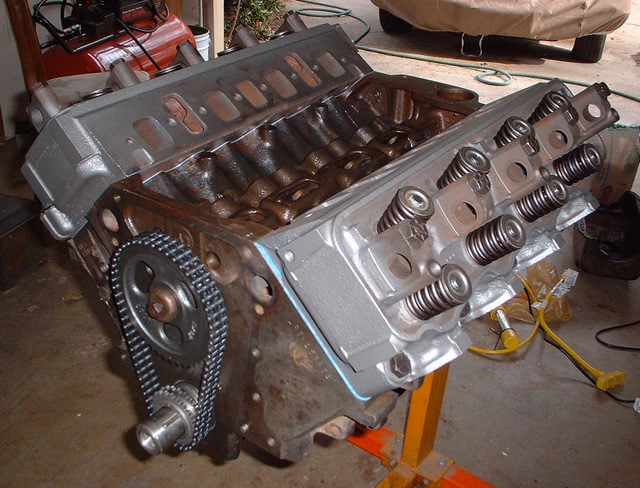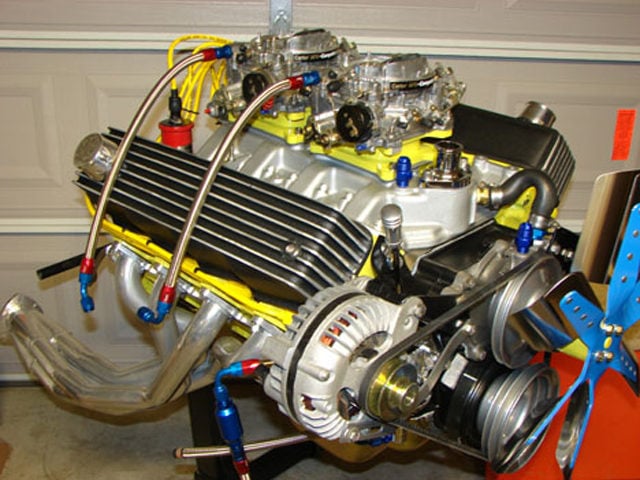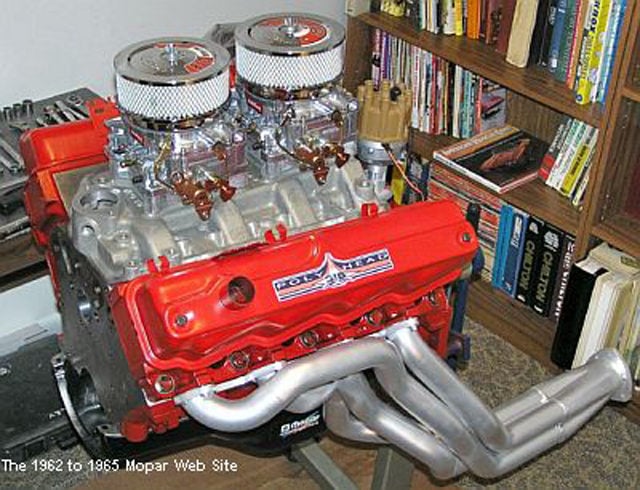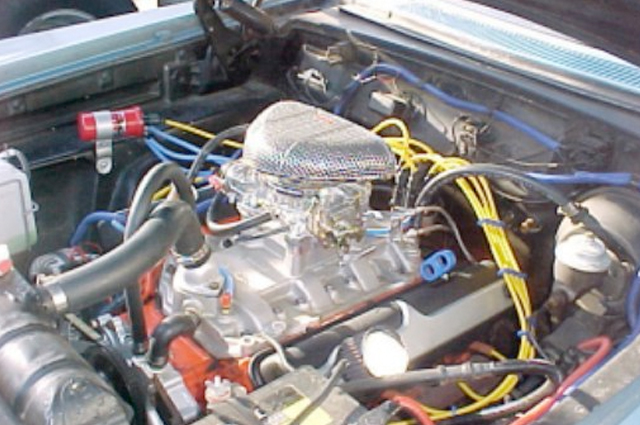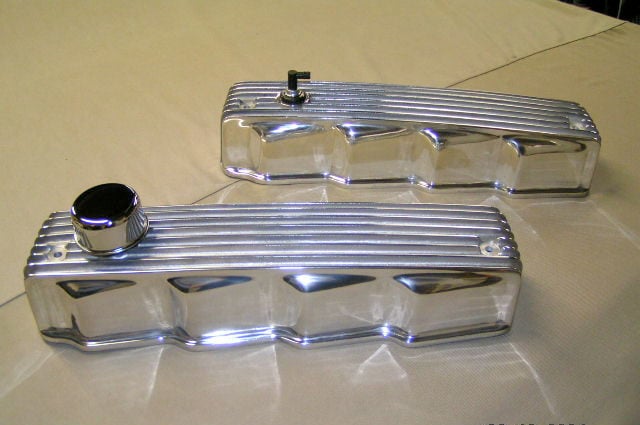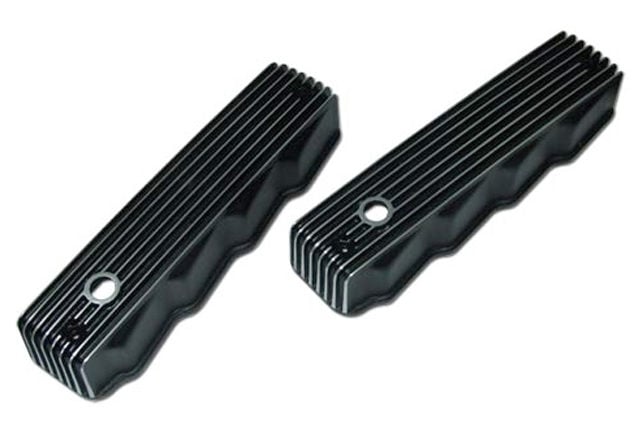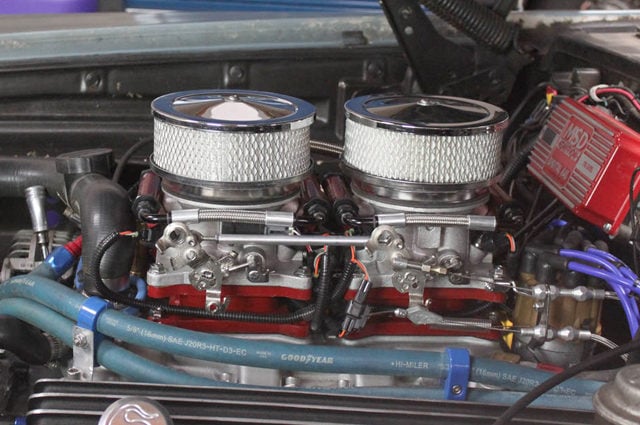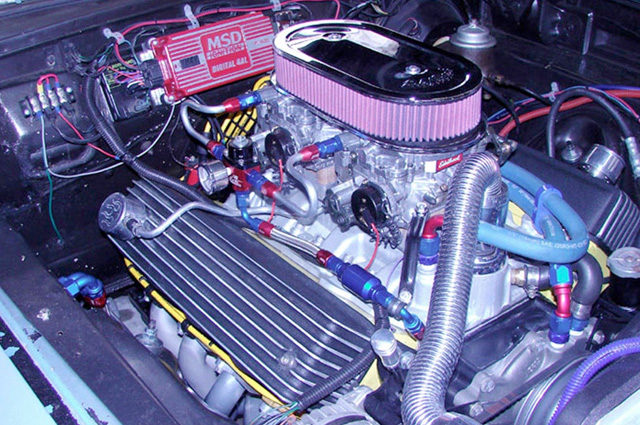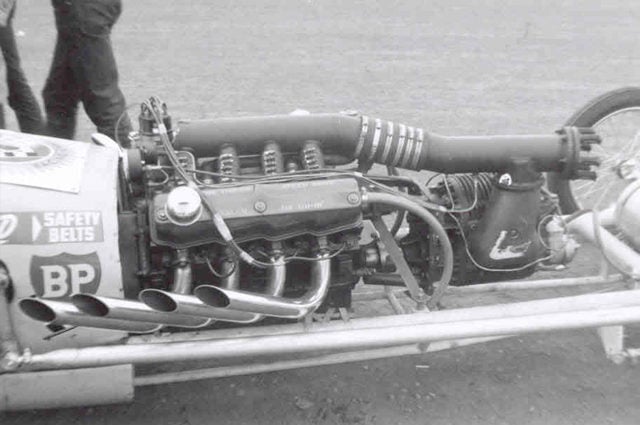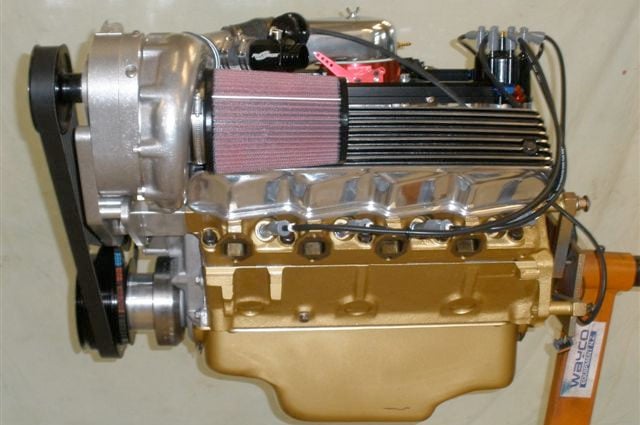A polyhead won’t be found wasting away in Margaritaville, but they might be wasting away in a wrecking yard. This polyhead is a Mopar engine that has some interesting followers, as well as a lot of people who could do without it. Considered the “yank it out and put in a big block” engine, most people who have a poly 318 have heard it all.
The Chrysler Polysphere, named for it’s polyspherical combustion chamber, was produced from 1956 to 1966 here in the states, and until 1967 in Canada. It had a similar design to the HEMI, but was less costly to build than the HEMI. The Poly engines had a single rocker shaft instead of a pair, as found on the HEMI, but you can’t mistake the canted valves. Eventually, they were replaced because of the cost.
The performance was better than the LA that replaced it, but it was a very heavy engine that didn’t have a lot of performance parts available for it. The Mopar 440 big block was just a few pounds heavier, so this 318 was quite a heavy engine considering. But it was efficient, if anything, and the design of the cylinder heads made it breathe better and it wasn’t so bad on the fuel mileage, either.
To put some numbers together for you, in 1957 a factory dual quad Poly 318 was rated at 290 hp! A single 4-bbl was rated at 260 hp in 1962, and that same year a 2-bbl was rated at 230 hp. So what was the horsepower rating for a 318 LA motor that replaced the Poly? In 1967, a 318 4-bbl was rated at about 230, that means that based on cylinder head design alone the LA basically lost about 30 horsepower.
The predecessor to the later LA engines, the Poly was an A engine that had several displacements: 277, 301, 303, 313, 318, & 326 cubic inches, the more popular engine that you will hear about is the 318. The first Dodge Charger in 1966 was available with the 318 A, but it had some stiff competition because that was also the first year that you could get the famed Street HEMI.
The real difference between the A series and LA series engines are the cylinder head and valvetrain designs. The cylinder head has a scallop shape on the exhaust side, and the intake and exhaust ports are directly across from each other just like the HEMI. Also like the HEMI, the intake valves are on the intake side of the cylinder head, and the exhaust valves are on the exhaust side. The LA series engines have all valves side by side on the intake side of the head. For this reason, the camshaft of the A is not interchangeable with the LA, nor are the intake or exhaust manifolds.
A couple of built Poly 318's, both with the dual quad intake made of unobtanium. You can still get .090 over pistons, and the block can actually handle .120 over.
While the Poly block is different from the LA, there are a lot of interchangeable parts between the two. You can install a Mopar 4 inch Stroker crankshaft in the A block with some minor trimming for clearance, and the timing cover from an LA can fit on the A block. You can also use the LA distributor on the Poly, and people have upgraded the ignition and alternator to that of the later LA series for years.
One interesting thing about the Poly is that it came stock with a high volume oil pump, and if you want a high volume oil pump for the LA engine, it’s the same part number as the Poly oil pump. This pump is readily available at most auto parts stores. All in all, the Poly motor is unique, and even has it’s own following of loyal Polyheads over at Yahoo Groups. The group has nearly 600 members who are all in love with the Poly, the engine many other Mopar lovers call a “boat anchor”. The 1962 to 1965 Mopar Web Site even has an entire page dedicated to this unloved motor, with all sorts of information and links.
Why the Poly?
It’s a question that gets asked quite often, and after a while you learn to take it all with a grain of salt. The Poly was standard equipment on this 1965 Plymouth Belvedere II; there were never any plans to drag race or even to go hi-po, the plan was to have a nice car to drive and to cruise in.
Most people these days like to have gobs of horsepower and they spend thousands building an engine with 600+ ponies, but unfortunately most of those cars remain in a locked garage and don’t spend much time on the street. This car with the Poly is drivable, it’s not going to win any races but it doesn’t sit in a garage for months at a time, either.
But it’s more than that with the Poly 318, it’s just different. Everyone and their brother who has a Mopar has a big block, or a HEMI. This car can be at a car show and even the Mopar guys will ask, “What engine is that?”.
They’ve never seen a built, dual quad Poly 318 with huge aluminum valve covers.
When this Plymouth was purchased, the owner said it had a 318 and nothing was said about it being a Poly. Most people who have owned other 1970’s Mopars were used to the LA motor. So hearing “318” wasn’t anything out of the ordinary, you would have to know that the LA 318 didn’t exist until 1967. Without that bit of trivia, you wouldn’t know that there weren’t many parts available for the 318 in this Belvedere. When this car was seen for the first time over a decade ago, the prior owner had painted the entire engine HEMI orange, and the entire engine bay was black.
There was a slight orange mist all over the place, clearly nothing was masked off and the engine was painted last. It didn’t initially sink in that the engine was a Poly, instead of the LA. So the car changed hands without concern, and work started almost immediately when the car got to its new home, cleaning it up and then trying to find performance parts for the 318.
The only aftermarket valve cover you can get for your Poly 318 comes from Australia.
A closer look while under the hood, the scallops in the valve covers were different and the assumption was made that the guy lied about it being a 318. It was likely that the heavy coat of orange that was on everything distracted just enough attention from the shape of the valve covers, and until one takes a closer look it is very similar to any other engine. But the differences are definitely there, however subtle they may be. The scalloped valve covers and the intake/exhaust configuration would be a dead giveaway now, but then, not so much.
Hard To Find Parts
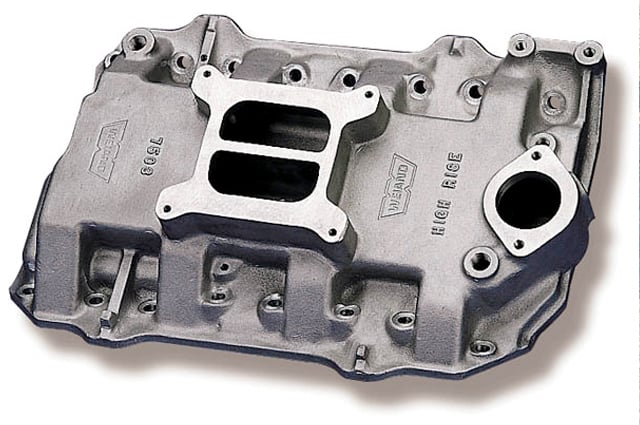 At that time, about a decade ago, one manufacturer made an intake manifold for the Poly 318: Weiand, part number 7503, and it was about 205 bucks from the likes of Summit Racing. Eventually, Weiand pulled the plug on the manifold and they are no longer being made, despite the pleas and begging being done by the Polyheads.
At that time, about a decade ago, one manufacturer made an intake manifold for the Poly 318: Weiand, part number 7503, and it was about 205 bucks from the likes of Summit Racing. Eventually, Weiand pulled the plug on the manifold and they are no longer being made, despite the pleas and begging being done by the Polyheads.
What this means is that if you want an aluminum four-barrel for your Poly 318, you must hit the internet and expect to pay far more than they were ever worth. While you’re searching, however, you might just find a couple other manifolds that are being offered up for gawdawful amounts of money: an aluminum dual quad or an aluminum six-pack manifold were also made at one time, but are now very difficult to find, and are two to three times their original price.
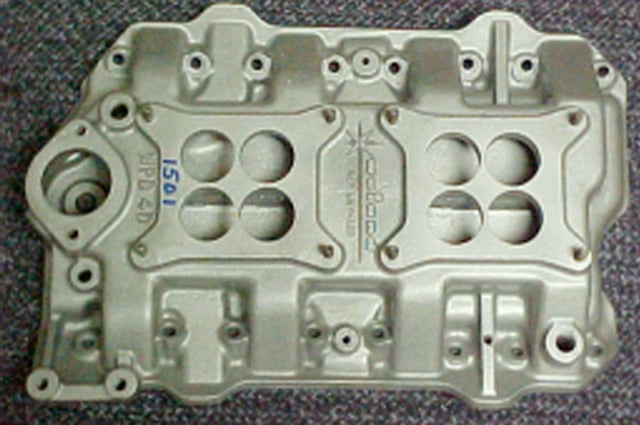 A Weiand 7503, used, now sells for about $500-700, and if someone has a new one on the shelf you’re lucky if you get it for under $700, the bidding can get fierce on eBay. A dual quad Weiand intake has been seen as high as $1000 for a decent one, and $800 for one in okay shape. A six-pack manifold will go between $600-800, typically, and there are two patterns: the three bolt carb base and the four bolt carb base. Edelbrock was in on these, as well.
A Weiand 7503, used, now sells for about $500-700, and if someone has a new one on the shelf you’re lucky if you get it for under $700, the bidding can get fierce on eBay. A dual quad Weiand intake has been seen as high as $1000 for a decent one, and $800 for one in okay shape. A six-pack manifold will go between $600-800, typically, and there are two patterns: the three bolt carb base and the four bolt carb base. Edelbrock was in on these, as well.
Mopar did have a cast iron dual quad manifold that weighed a ton, and a very rare aluminum one is seen occasionally. For the most part, you’ll find factory cast iron two barrel manifolds quite often and the occasional factory cast iron four barrel manifold.
For a pretty long time, there weren’t many headers to be found for the Poly 318, and of those you could find they weren’t very good headers for guys with cars as they were primarily made for the early trucks with a Poly 318. There was one ‘person’ who was making log-style headers, but people who had sent their money to him were still waiting 8 years later and never saw their headers. Fortunately, they were inexpensive – about $160 and worth just about that since they really didn’t incorporate much technology in them.
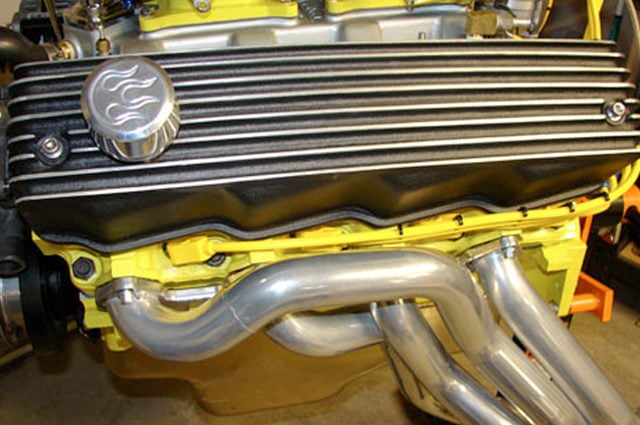
Real headers for the Poly 318 cars, and some truck headers, won’t fit the many of the cars. There were attempts to satisfy the car market, but most never really hit the mark.
But thanks to urging from Bill Richardson at Mopar Mecca, TTi Exhaust in Corona, CA, answered his call and we finally got real headers for our Poly 318. This car, and the original Poly that was in it, were donated to TTi for a couple days so they could do the initial test-fitting of the first set of headers. They’re awesome headers and they fit snugly – the Poly is a rather tight fit in the engine bay.
But the headers are not cheap, so expect to pay over $700 for these ceramic coated, mandrel-bent, CNC-machined headers. The only other alternative is to have someone make them for you, which will likely cost you just about the same amount.
Fiinally, the latest modification done to this Poly 318. It’s not inexpensive, but at the risk of sounding cliche it might just pay for itself over time. Disappointed with the dual carbs and the constant adjusting that had to be done to them, the second pair of carburetors that this dual quad saw were removed to make way for a FAST dual quad EZ-EFI kit that was installed on this Plymouth.
We have a feature article on the FAST EZ-EFI install, and we can tell you that it’s awesome. Not only did we gain about 4 miles per gallon on long trips, but now that the engine is running better and the fuel system is more efficient we actually gained 21 horsepower. Cold start problems are a thing of the past, constant tuning is no more, and it just looks really cool
Most people ask “why?”, but to those of us who like to have something a little different, something that nobody else has, we have to respond with, “why not?”. If brute horsepower is what you want, this is not the engine for you. There have been some cases where people have built the daylights out of their Poly and saw 500 horsepower, but that’s at a price that exceeds the cost of a high horsepower small block. The Poly is different, and even though it’s not all that great it’s really not all that bad, either. Like beer, it’s an acquired taste that does take some getting used to, but it’s hard not to like once you’ve indulged it a little.



